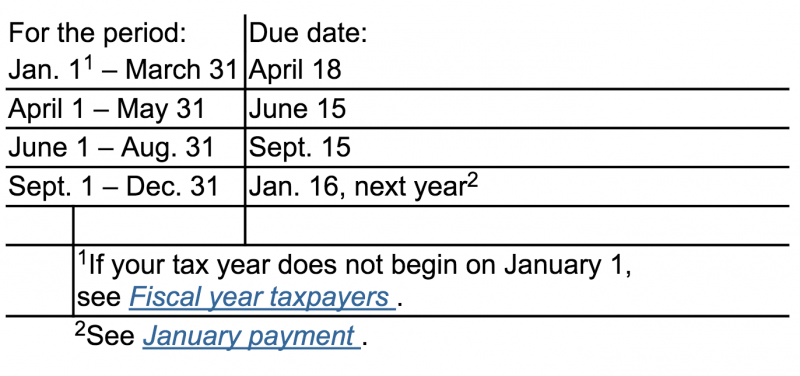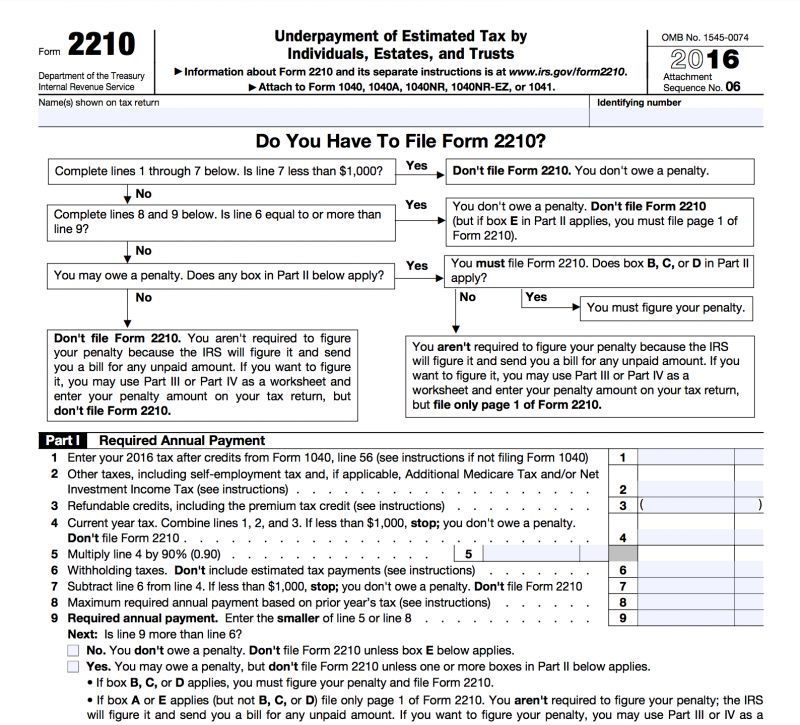If you underpay estimated taxes, you may be subject to penalty. IRS Form 2210 Underpayment of Estimated Tax by Individuals, Estates, and Trusts is the form that you use to report this.
With proper planning, all penalties can be avoided, but in order to do this you need to understand the rules of Estimated vs Withholding tax.
Withholding tax is what people have deducted from payroll. The most interesting facet to this tax is because of the method, it is always considered to be timely filed. This means if you pay $0 in taxes throughout the year, but run a single ‘special’ payroll at the end of December, providing you pay ‘enough’ of your obligation for the year, you avoid Withholding Tax penalties. The limit for penalty occurs if you owe more than $1,000 after all payments.
For the sake of clarity, let’s assume you have a $10,000 tax liability for the year, and you pay $9,500 via a payroll withholding in December, you get no penalty.
Estimated tax is a separate payment that can be made directly to the IRS, and can be paid by check, or credit card. Estimated tax does not carry the same privilege of being ‘timely filed’ that withholding tax carries. Therefore, if you were to take the same situation, where there is a $10,000 liability and you were to pay $9,500 in December via Credit card, you would be subject to a penalty that goes back to Q1 of that year.

The distinction is small, but very important. The quality of the Withholding Tax being considered timely filed is a very useful tool when people haven’t paid taxes through the year. We see this when new self employed people have started earning money, but haven’t started paying themselves.
Another time where this nuance may come into play is for when people try to manipulate their exemptions and ‘make up’ the difference via Estimated Tax. If they do this, the Estimated Tax payments must be made for each applicable quarter, and cannot be simply ‘trued up’ via an end of year lump sum.
If you want test it for yourself, work through form 2210.

Check out line 6, this gives you the information that Withholding is treated differently from Estimated tax, regardless of the date of the transaction.
Line 7 shows how with a ‘timely filed’ line 6 amount, and a balance less than $1,000 in taxes owed, you do not have to complete the penalty form.
Thank you for the very straightforward explanation.
Matt,
What do you recommend people use as a percentage of profit to pay as a estimated payment if you are in your first year of business or don’t have steady profits that can be estimated for each payment?
It depends… if this is a side gig then your primary income tax rate dictates the rate of tax you pay on ‘profit’. Plus, some people have no profit whereas others have lots. I personally don’t like profit because it means paying taxes, so I like to address suitable deductions before that stage.
Maybe take your current tax bracket rate (Fed/State) and use that to make the payments based on what you estimate the profit to be.
Isn’t there a rule that if your tax liability for the year is far greater then the previous year, you can pay 105% of the previous year taxes, in estimated taxes, and not incur any penalties no matter how great your present year tax liability. Of course you would still have to pay the remaining tax liability for the year by April 15.
Example: last year taxes were $10,000. This year taxes are $50,000 but would only have to pay $10,500 in estimated taxes. Would not incur any penalty and pay the remaining taxes of $39,500 by April 15.
No. You might be thinking about safe harbor, but that is a different thing.
Safe harbor seems to be the case here, no?
(either 100% or 110% of last year, divided to quarters)
https://www.irs.gov/publications/p17/ch04.html
I am a PA and graduated in November. I work a 1099 and a W2. I didnt make enough last yr to owe tax and got a small EIC. Am I correct that I am exempt from prepaying on my 1099 but am still required to have witholding taken out on the W2? Trying to max cash flow now and get a leg up on loan repmt.
Matt
Or would that only be true if W2 wh covered at least 90% of the 1099 tax owed?